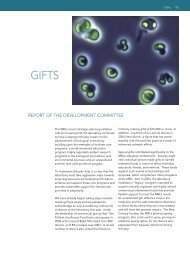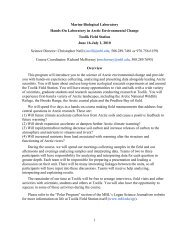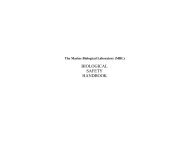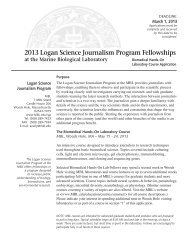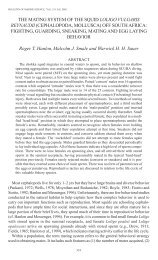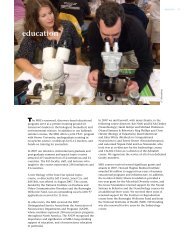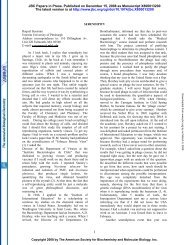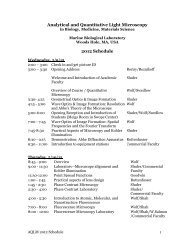An Ethogram of Body Patterning Behavior in the Biomedically and ...
An Ethogram of Body Patterning Behavior in the Biomedically and ...
An Ethogram of Body Patterning Behavior in the Biomedically and ...
You also want an ePaper? Increase the reach of your titles
YUMPU automatically turns print PDFs into web optimized ePapers that Google loves.
56 R. T. HANLON ET AL<br />
consort males when an <strong>in</strong>truder male approaches. Accentu-<br />
ated testis is a male-only component shown when <strong>the</strong><br />
chromatophores directly above <strong>the</strong> testis are retracted while<br />
<strong>the</strong> squid mantle is o<strong>the</strong>rwise dark, thus accentuat<strong>in</strong>g <strong>the</strong><br />
whiteness <strong>of</strong> <strong>the</strong> organ (Fig. 2F). This component was seen<br />
frequently <strong>in</strong> s<strong>in</strong>gle or mate-paired males when reproductive<br />
behavior was actively occurr<strong>in</strong>g <strong>in</strong> <strong>the</strong> school. Accentuated<br />
oviducal gl<strong>and</strong> is a female-only component analogous <strong>in</strong><br />
form <strong>and</strong> function to Accentuated testis <strong>in</strong> <strong>the</strong> male. This<br />
was <strong>of</strong>ten seen <strong>in</strong> females paired with consort males. All <strong>of</strong><br />
<strong>the</strong>se light components except White dorsal stripe have been<br />
seen commonly <strong>in</strong> o<strong>the</strong>r L.oligo spp.<br />
Light iridescent chromatic components<br />
Each <strong>of</strong> <strong>the</strong> light iridescent chromatic components is<br />
common to Loligo spp., <strong>and</strong> comparable color images<br />
may be viewed <strong>in</strong> Hanlon (1982). Dorsal mantle collar<br />
iridophores are on <strong>the</strong> anteriormost portion <strong>of</strong> <strong>the</strong> man-<br />
tle, <strong>and</strong> <strong>the</strong>y appear as bright yellow or p<strong>in</strong>k iridescence;<br />
this component tends to produce disruptive coloration by<br />
break<strong>in</strong>g up <strong>the</strong> longitud<strong>in</strong>al aspect <strong>of</strong> <strong>the</strong> squid’s body.<br />
It <strong>and</strong> <strong>the</strong> next component are usually seen on calm<br />
squids near <strong>the</strong> bottom <strong>in</strong> <strong>the</strong> Clear pattern. Dorsal iri-<br />
dophore splotches occur on <strong>the</strong> dorsal mantle <strong>and</strong> head.<br />
They are a dist<strong>in</strong>ctive yellow or golden color, <strong>and</strong> <strong>the</strong>y<br />
help to produce general camouflage (Fig. 2E). Iridescent<br />
arm stripes extend most <strong>of</strong> <strong>the</strong> length <strong>of</strong> <strong>the</strong> first three<br />
pairs <strong>of</strong> arms. These are usually expressed lightly dur<strong>in</strong>g<br />
camouflage <strong>in</strong> <strong>the</strong> Clear pattern, but dur<strong>in</strong>g agonistic<br />
encounters <strong>the</strong>y can be expressed very brightly (see color<br />
illustration <strong>in</strong> Hanlon, 1982). Iridescent sclera is <strong>the</strong><br />
bright silver iridescence on <strong>the</strong> back (or sclera) <strong>of</strong> <strong>the</strong><br />
eye; squids have <strong>the</strong> ability to obscure this with chro-<br />
matophores with <strong>the</strong> Shaded eye component. Dorsal iri-<br />
dophore sheen is somewhat rare <strong>and</strong> is only noticeable<br />
from <strong>the</strong> side. Its function is unclear but may aid cam-<br />
ouflage <strong>in</strong> open water by disrupt<strong>in</strong>g <strong>the</strong> body shape. None<br />
<strong>of</strong> <strong>the</strong>se are unique to L. pealei but are shared by o<strong>the</strong>r<br />
Loligo spp.<br />
Light polarization chromatic components<br />
These l<strong>in</strong>ear polarization components are newly de-<br />
scribed for Loligo spp. Polarized arms are highly polarized<br />
reflections that create <strong>the</strong> most conspicuous component <strong>of</strong><br />
polarization (Fig. 3A, B). This component <strong>of</strong>ten exceeds<br />
partial polarization <strong>of</strong> 0.75, which is noteworthy because<br />
Flamarique <strong>and</strong> Hawryshyn (1997) showed that <strong>the</strong> natural<br />
underwater light field rarely exhibits partial polarization as<br />
high as 0.67. The orientation <strong>of</strong> polarization can be equal <strong>in</strong><br />
all arms (Fig. 3A), or it may differ between arms (Fig. 3B).<br />
Sk<strong>in</strong> surface polarization results from <strong>the</strong> difference <strong>in</strong><br />
refractive <strong>in</strong>dexes between <strong>the</strong> squid’s body <strong>and</strong> <strong>the</strong> water,<br />
so that light reflected from any area <strong>of</strong> <strong>the</strong> sk<strong>in</strong> may be<br />
partially polarized (Fig. 3C). However, <strong>the</strong> partial polariza-<br />
tion <strong>in</strong> this case is mostly low, rarely reach<strong>in</strong>g 0.5. Polar-<br />
ized eyes result from reflection by iridophore cells that<br />
surround <strong>the</strong> eye (Fig. 3D, arrow). The dorsal mantle occa-<br />
sionally reflects light that is partially polarized, result<strong>in</strong>g <strong>in</strong><br />
Polarized dorsal sheen. The orientation <strong>of</strong> polarization can<br />
vary, reach<strong>in</strong>g 20 degrees from horizontal. This polarization<br />
reflection corresponds to <strong>the</strong> area <strong>of</strong> <strong>the</strong> Dorsal iridophore<br />
sheen, although <strong>the</strong> two components do not always co<strong>in</strong>cide<br />
<strong>in</strong> time. The source <strong>of</strong> this polarization component can be<br />
ei<strong>the</strong>r reflection from iridophores on <strong>the</strong> mantle or Sk<strong>in</strong><br />
surface polarization. Ow<strong>in</strong>g to <strong>the</strong> limitations <strong>of</strong> <strong>the</strong> equip-<br />
ment used to record polarization patterns, <strong>the</strong>se are probably<br />
not <strong>the</strong> only polarization components that squids can show.<br />
Dark chromatic components<br />
All dark is <strong>the</strong> opposite <strong>of</strong> Clear: all or most chromato-<br />
phores are exp<strong>and</strong>ed to some degree. The maximal expres-<br />
sion <strong>of</strong> All dark (Fig. 2D) produces an overall deep brown<br />
coloration; it is characteristic <strong>of</strong> alarmed squids. However,<br />
<strong>the</strong> chromatophores need not be maximally exp<strong>and</strong>ed, <strong>and</strong><br />
thus <strong>the</strong>re are ranges <strong>of</strong> darkness. Often squids are <strong>in</strong> a<br />
“normal” or “basic” coloration that is roughly between<br />
Clear <strong>and</strong> All dark, produc<strong>in</strong>g an overall amber body pattern<br />
(Fig. 2A). There is also a strik<strong>in</strong>g unilateral expression <strong>of</strong><br />
All Dark (Fig. 1). Dark arms/head is variable <strong>in</strong> expression<br />
(see Fig. 1) <strong>and</strong> is opposite to White arms/head. It is seen<br />
typically <strong>in</strong> mat<strong>in</strong>g pairs <strong>and</strong> may represent a mild state <strong>of</strong><br />
alarm. Dark head is expansion <strong>of</strong> all <strong>the</strong> chromatophores<br />
around <strong>the</strong> head <strong>of</strong> <strong>the</strong> animal (but not <strong>the</strong> arms), caus<strong>in</strong>g <strong>the</strong><br />
head to appear almost black. This component is frequently<br />
seen <strong>in</strong> mate pairs near <strong>the</strong> egg mop <strong>and</strong> probably represents<br />
a low-grade alarm signal.<br />
Four striped components occur <strong>in</strong> L. pealei, one used for<br />
crypsis <strong>and</strong> three used dur<strong>in</strong>g <strong>in</strong>traspecific agonistic con-<br />
tests. Dark dorsal stripe extends halfway or fully down <strong>the</strong><br />
mid-dorsal mantle. Seen ma<strong>in</strong>ly on calm squids, it appar-<br />
ently aids camouflage because it covers some <strong>of</strong> <strong>the</strong> bright<br />
organs such as <strong>the</strong> testis, oviducal gl<strong>and</strong>s, <strong>and</strong> <strong>in</strong>k sac.<br />
Ventral mantle stripe is a th<strong>in</strong>, dist<strong>in</strong>ct l<strong>in</strong>e <strong>of</strong> fully ex-<br />
p<strong>and</strong>ed chromatophores. L. pealei, <strong>in</strong> contrast to L. plei but<br />
<strong>in</strong> common with L. vulgaris reynaudii, L. vulgaris, <strong>and</strong> L.<br />
forbesi, shows no protrusile flap <strong>of</strong> sk<strong>in</strong> when exhibit<strong>in</strong>g this<br />
component (Hanlon, 1988; Hanlon et al., 1994). The func-<br />
tion <strong>of</strong> this component is uncerta<strong>in</strong>, but it is seen commonly<br />
on mat<strong>in</strong>g pairs <strong>and</strong> on males dur<strong>in</strong>g mate guard<strong>in</strong>g. Males<br />
<strong>of</strong>ten swim just above females, <strong>and</strong> pairs are frequently<br />
approached by o<strong>the</strong>r squids from below, so <strong>the</strong> ventral



